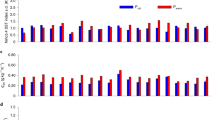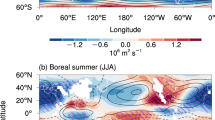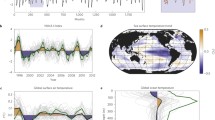Abstract
We identify and remove the main natural perturbations (e.g. volcanic activity, ENSOs) from the global mean lower tropospheric temperatures (T LT ) over January 1979 - June 2017 to estimate the underlying, potentially human-forced trend. The unaltered value is +0.155 K dec−1 while the adjusted trend is +0.096 K dec−1, related primarily to the removal of volcanic cooling in the early part of the record. This is essentially the same value we determined in 1994 (+0.09 K dec−1, Christy and McNider, 1994) using only 15 years of data. If the warming rate of +0.096 K dec−1 represents the net T LT response to increasing greenhouse radiative forcings, this implies that the T LT tropospheric transient climate response (ΔT LT at the time CO2 doubles) is +1.10 ± 0.26 K which is about half of the average of the IPCC AR5 climate models of 2.31 ± 0.20 K. Assuming that the net remaining unknown internal and external natural forcing over this period is near zero, the mismatch since 1979 between observations and CMIP-5 model values suggests that excessive sensitivity to enhanced radiative forcing in the models can be appreciable. The tropical region is mainly responsible for this discrepancy suggesting processes that are the likely sources of the extra sensitivity are (a) the parameterized hydrology of the deep atmosphere, (b) the parameterized heat-partitioning at the oceanatmosphere interface and/or (c) unknown natural variations.
Similar content being viewed by others
References
Bianchi, F., and Coauthors, 2016: New particle formation in the free troposphere: A question of chemistry and timing. Science, 2016, doi: 10.1126/Science.aad5456.
Bindoff, N. L., and Coauthors, 2013: Detection and attribution of climate change: From global to regional. In Climate Change 2013: The Physical Science Basis. T. F. Stocker et al. Eds., Cambridge University Press, 867–952.
Choi, Y.-S., H. Cho, C.-H. Ho, R. S. Lindzen, S. K. Park, and W. Yu, 2014: Influence of non-feedback variations of radiation on the determination of climate feedback. Theor. Appl. Climatol., 115, 355–364, doi:10.1007/ s00704-013-0998-6.
Christy, J. R., 2017: Lower and mid-tropospheric temperature. [in State of the Climate 2016]. Bull. Amer. Meteor. Soc., 98, 16, doi:10.1175/ 2017BAMSStateoftheClimate.1.
Christy, J. R., and S. Drouilhet, 1994: Variability in daily, zonal mean lowerstratospheric temperatures. J. Climate, 7, 106–120.
Christy, J. R., and R. T. McNider, 1994: Satellite greenhouse signal. Nature, 367, 325.
Christy, J. R., W. B. Norris, and R. T. McNider, 2009: Surface temperature variations in East Africa and possible causes. J. Climate, 22, 3342–3356, doi:10.1175/2008JCLI2726.1.
Christy, J. R., B. Hermon, R. Pielke Sr., P. Klotzbach, R. T. McNider, J. J. Hnilo, R. W. Spencer, T. Chase, and D. Douglass, 2010: What do observational datasets say about modeled tropospheric temperature trends since 1979? Remote Sens., 2, 2148–2169, doi:10.3390/rs2092148.
Christy, J. R., R. W. Spencer, and W. B. Norris, 2011: The role of remote sensing in monitoring global bulk tropospheric temperatures. Int. J. Remote Sens., 32, 671–685, doi:10.1080/01431161.2010.517803.
Collins, M., and Coauthors, 2013: Long term climate change: Projections, commitments and irreversibility. In Climate Change 2013: The Physical Science Basis. T. F. Stocker et al. Eds., Cambridge University Press, 1029–1136.
Flato, G., and Coauthors, 2013: Evaluation of climate models. In Climate Change 2013: The Physical Science Basis. T. F. Stocker et al. Eds., Cambridge University Press, 741–866.
Forster, P., and Coauthors, 2007: Changes in atmospheric constituents and radiative forcing. In Climate Change 2007: The Physical Science Basis. S. Solomon et al. Eds., Cambridge University Press, 130–234.
Free, M., D. J. Seidel, J. K. Angell, J. Lanzante, I. Durre, and T. C. Peterson, 2005: Radiosonde atmospheric temperature products for assessing climate (RATPAC): A new data set of large-area anomaly time series. J. Geophys. Res., 110, D22101, doi:10.1029/2005JD006169.
Haimberger, L., C. Tavolato, and S. Sperka, 2012: Homogenization of the global radiosonde temperature dataset through combined comparison with reanalysis background series and neighboring stations. J. Climate, 25, 8108–8131, doi:10.1175/jcli-d-11-00668.1.
Hope, A. P., T. P. Canty, R. J. Salawitch, W. R. Tribett, and B. F. Bennett, 2017: Forecasting global warming. In Paris Climate Agreement: Beacon of Hope. R. J. Salawitch et al. Eds., Springer Climate, 51–113, doi:10.1007/978-3-319-46939-3_2.
Jiang, J. H., and Coauthors, 2012: Evaluations of cloud and water vapor simulations in CMIP5 climate models using NASA “A-Train” satellite observations. J. Geophys. Res., 117, D1410, doi:10.1029/2011JD017237.
Lindzen, R. S., and Y.-S. Choi, 2011: On the observational determination of climate sensitivity and its implications. Asia-Pac. J. Atmos. Sci., 47, 377–390, doi:10.1007/s13143-011-0023-x.
Mantua, N. J., and S. R. Hare, 2002: The Pacific decadal oscillation. J. Oceanography, 58, 35–44, doi:10.1023/A:1015820616384.
McKitrick, R. R., and T. J. Vogelsang, 2014: HAC robust trend comparisons among climate series with possible level shifts. Environmetrics, 25, 528–547, doi:10.1002/env.2294.
McNider, R. T., G. J. Steeneveld, A. A. M. Holtslag, R. A. Pielke Sr., S. Mackaro, A. Pour-Biazar, J. Walters, U. Nair, and J. Christy, 2012: Response and sensitivity of the nocturnal boundary layer over land to added longwave radiative forcing. J. Geophys. Res., 117, doi10.1029/2012JD017578.
Mears, C. A., and F. J. Wentz, 2009: Construction of the Remote Sensing Systems V3.2 atmospheric temperature records from the MSU and AMSU microwave sounders. J. Atmos. Oceanic Technol., 26, 1040–1056, doi:10.1175/2008JTECHA1176.1.
Mears, C. A., and F. J. Wentz, 2017: A satellite-derived lower tropospheric atmospheric temperature dataset using an optimized adjustment fro diurnal effects. J. Climate, 30, 7695–7718, doi:10.1175/JCLI-D-16-0768.1.
Meehl, G. A., A. Hu, J. M. Arblaster, J. Fasullo, and K. E. Trenberth, 2013: Externally forced and internally generated decadal climate variability associated with interdecadal Pacific Oscillation. J. Climate, 26, 7298–7310, doi:10.1175/JCLI-D-12-00548.1.
Myhre, G., and Coauthors, 2013: Anthropogenic and natural radiative forcing. In Climate Change 2013: The Physical Science Basis. T. F. Stocker et al. Eds., Cambridge University Press, 659–740.
National Academy of Sciences, 2003}: Cloud, water vapor, and lapse rate feedbacks. In Understanding Climate Change Feedbacks. National Research Council Ed., The National Academy Press, 166 pp
NOAA, 2017 cited: sstoi.indices. [Available online at http://www.cpc.ncep.noaa.gov/data/indices/sstoi.indices.]
NOAA, 2017 cited: sstoi.atl.indices. [Available online at http://www.cpc.ncep.noaa.gov/data/indices/sstoi.atl.indices.]
Pielke Sr., R. A., and Coauthors, 2007: Unresolved issues with the assessment of multidecadal global land surface temperature trends. J. Geophys. Res., 112, doi:10.1029/2006JD008229.
Santer, B. D., and Coauthors, 2014: Volcanic contribution to decadal changes in tropospheric temperature. Nat. Geosci., 7, 185–189, doi:10. 1038/ngeo2098.
Scafetta, N., 2013: Discussion on climate oscillations: CMIP5 general circulation models versus a semi-empirical harmonic model based on astronomical cycles. Earth Sci. Rev., 126, 321–357, doi:10.1016/j.earscirev.2013.08.008.
Schlesinger, M. E., and N. Ramankutty, 1994: An oscillation in the global climate system of period 65-70 years. Nature, 367, 723–726, doi:10. 1038/367723a0.
Sherwood, S. C., and N. Nishant, 2015: Atmospheric changes through 2012 as shown by iteratively homogenized radiosonde temperature and wind data (IUKv2). Environ. Res. Lett., 10, 054007, doi:10.1088/1748-9326/10/5/054007.
Spencer, R. W., and W. D. Braswell, 2010: On the diagnosis of radiative feedback in the presence of unknown radiative forcing. J. Geophys. Res., 115, D16109, doi:10.1029/2009JD013371.
pencer, R. W., J. R. Christy, and W. D. Braswell, 2017: UAH Version 6 global satellite temperature products: Methodology and results. Asia-Pac. J. Atmos. Sci., 53, 121–130, doi:10.1007/s13143-017-0010-y.
Stocker, T. F., and Coauthors, 2013: Technical Summary. In Climate Change 2013: The Physical Science Basis. T. F. Stocker et al. Eds., Cambridge University Press, 33–115.
Su, H., and Coauthors, 2017: Tightening of tropical ascent and high clouds key to precipitation change in a warmer climate. Nat. Commun., 8, 15771, doi:10.1038/ncomms15771.
van Oldenbrogh, G. J., 2016: Climate Data Explorer. [Available online at http://climexp.knmi.nl/selectfield_co2.cgi?someone@somewhere.]
Wolter, K., and M. S. Timlin, 2011: El Niño/Southern Oscillation behaviour since 1871 as diagnosed in the extended multivariate ENSO index. Intl. J. Climatol., 31, 1074–1087, doi:10.1002/joc.2336.
Author information
Authors and Affiliations
Corresponding author
Rights and permissions
About this article
Cite this article
Christy, J.R., McNider, R.T. Satellite bulk tropospheric temperatures as a metric for climate sensitivity. Asia-Pacific J Atmos Sci 53, 511–518 (2017). https://doi.org/10.1007/s13143-017-0070-z
Received:
Accepted:
Published:
Issue Date:
DOI: https://doi.org/10.1007/s13143-017-0070-z




